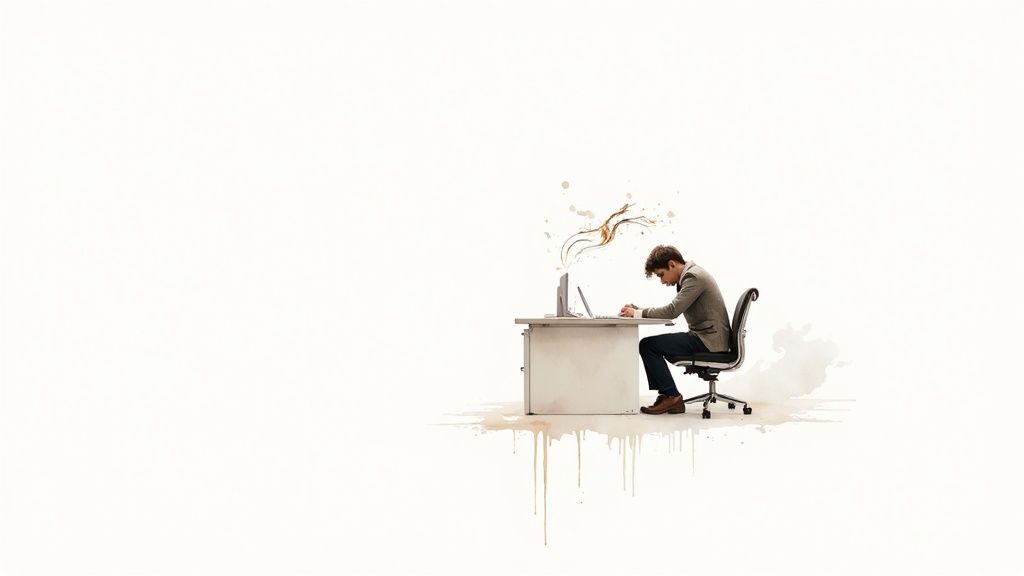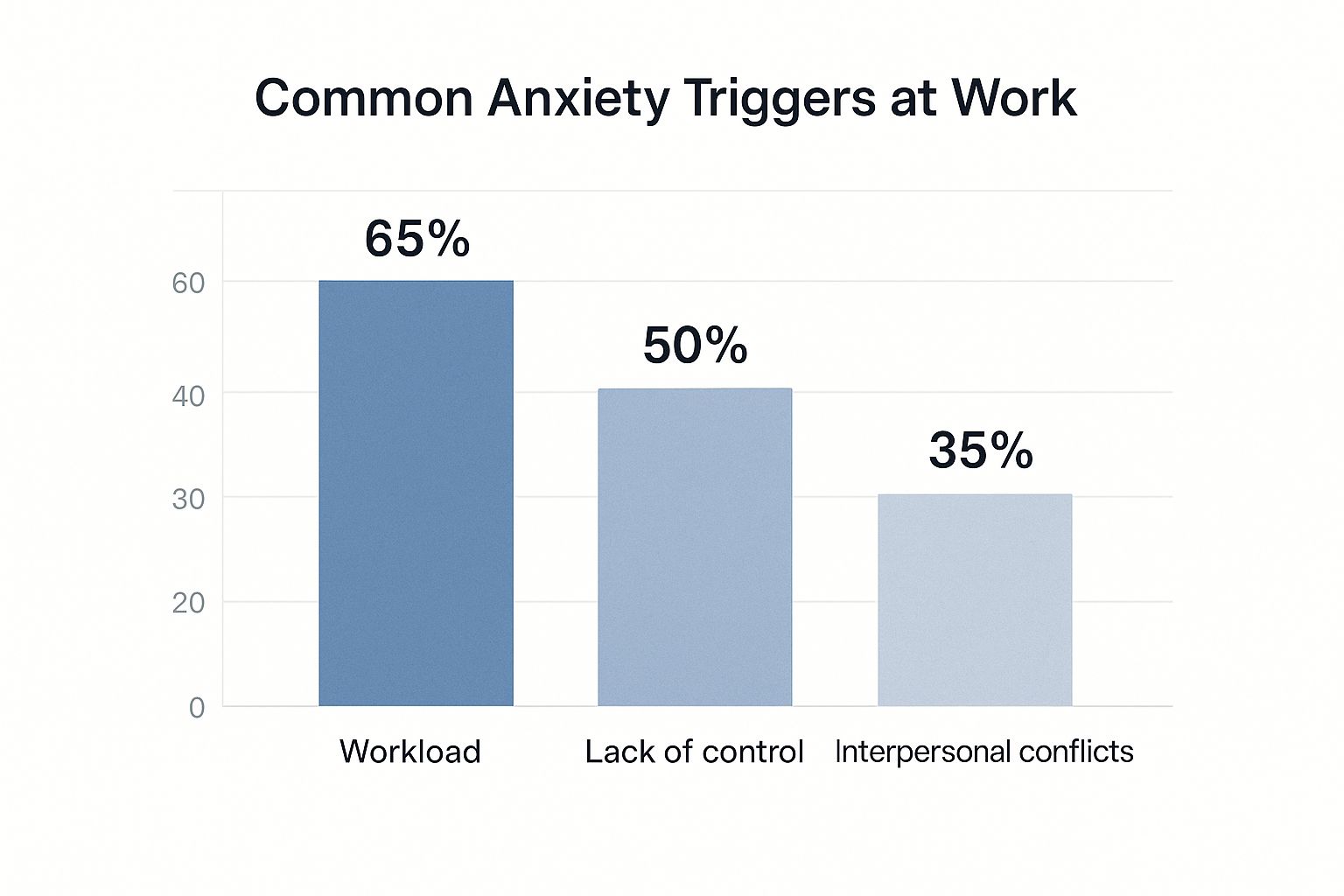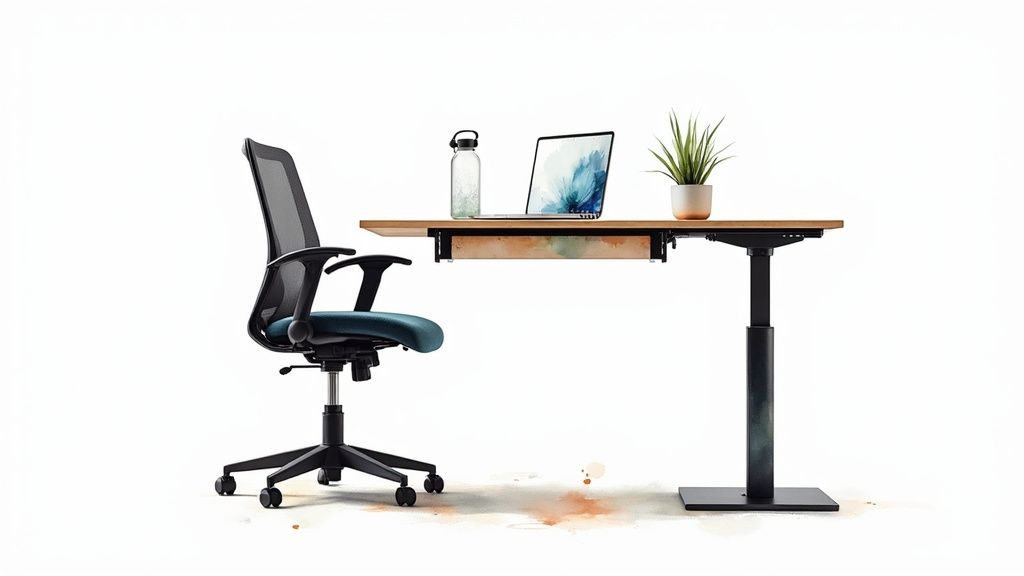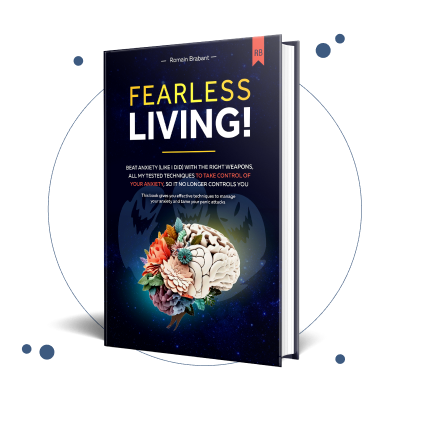
When anxiety and work collide, feeling overwhelmed is an incredibly common, shared experience. This isn't about ignoring the struggle. It's about seeing the clear path forward.
You can absolutely regain control and build a fulfilling professional life—not in spite of anxiety, but by learning to navigate it with skill and compassion.
Finding Hope in the Face of Workplace Anxiety

The constant pressure of deadlines, difficult colleagues, and performance reviews can feel like an impossible weight. If you're juggling anxiety at work, you are far from alone.
It's easy to feel isolated when your professional life feels controlled by worry, fear, or panic. But it's crucial to understand this is not a permanent state.
This guide is built on a simple yet powerful idea: healing is possible, and a panic-free work life is an achievable goal. It’s not about finding a magic cure. It's about equipping yourself with practical, actionable tools that make a real difference, day in and day out.
The Scale of Workplace Stress
The sheer impact of a stressful work environment is staggering. In the United States alone, workplace stress has become an epidemic, affecting over 83% of workers.
This isn't just a minor issue. It contributes to more than $300 billion in annual economic losses from things like absenteeism and reduced productivity. Even more sobering, it's linked to an estimated 120,000 deaths each year.
These aren't just abstract numbers; they represent millions of individuals whose well-being is compromised every single day. Seeing the scale of the problem helps validate your own experience and underscores why finding solutions is so important.
The goal is to move from simply surviving your workday to truly thriving in it. This shift begins with understanding that you have the power to change your relationship with anxiety.
Throughout this guide, we'll explore concrete strategies to help you navigate your career with more confidence. You’ll learn how to pinpoint your specific triggers, apply discreet coping techniques right at your desk, and build resilience for the long haul. Remember, every small step forward is a victory on the path to a calmer, more controlled life.
Pinpointing Your Workplace Anxiety Triggers
To get a real handle on anxiety, you have to play detective in your own work life. This means looking past the vague feeling of dread and figuring out what’s actually setting it off.
Think of it like microphone feedback—you don't junk the whole sound system. You find the source of the squeal and make an adjustment. The same goes for workplace anxiety. It’s rarely the entire job; it's usually specific moments, tasks, or interactions that are the real culprits.
Becoming an Anxiety Detective
A simple but incredibly powerful tool for this is a Trigger & Response Journal. This isn't just a diary; it's more like a logbook for your emotional and physical reactions. The goal is to draw a straight line from a specific event (the trigger) to how you felt and what your body did (the response).
For example, maybe your heart starts hammering every time an email from a certain senior manager lands in your inbox. Or perhaps your stomach twists into a knot right before the weekly team meeting. When you write these things down, you start to see patterns emerge from what just felt like chaos.
By looking at these real-world moments, you shift from feeling vaguely overwhelmed to having a clear map of your triggers. That knowledge is power. It lets you anticipate, prepare, and ultimately, take back control.
So, where do these triggers tend to hide? Most of the time, they fall into a few key areas:
- Tasks and Deadlines: A monster project looming on the horizon, a spreadsheet from hell, or the sheer terror of a public presentation.
- Interactions: Getting tough feedback from your boss, trying to navigate after-work social events, or just dealing with that one uncooperative colleague.
- Environment: The constant hum of a noisy open-plan office, feeling like you're being digitally watched, or a nagging lack of control over your own work.
Mapping Your Personal Triggers
This infographic breaks down some of the most common sources of workplace anxiety, showing just how often certain pressures get to people.

As the data shows, a heavy workload is a massive factor for most people, but issues like a lack of control and difficult coworkers aren't far behind. Your journal will help you figure out which of these—or other, more unique factors—are the ones that matter for you.
To help you get started, this table connects common workplace triggers with the signals your body and mind might be sending you. Use it to build that crucial self-awareness.
Decoding Your Workplace Anxiety Signals
| Common Workplace Trigger | Potential Physical Signals | Potential Emotional/Cognitive Signals |
|---|---|---|
| Receiving an unexpected email from a senior leader | Heart racing, shallow breathing, tightness in chest | Mind going blank, immediate "what did I do wrong?" thought |
| Facing a tight project deadline | Headaches, muscle tension in shoulders, fatigue | Feeling overwhelmed, irritability, difficulty concentrating |
| Conflict or negative feedback from a colleague | Upset stomach, sweating, feeling shaky | Rumination (replaying the event), defensiveness, self-doubt |
| Leading a team meeting or presentation | Dry mouth, trembling hands, feeling dizzy | Fear of judgment, catastrophic thinking ("I'm going to fail") |
| A noisy or distracting open-office environment | Feeling jittery or on-edge, clenched jaw | Inability to focus, heightened sensitivity to interruptions |
Once you see these connections on paper, they become less mysterious and a lot more manageable.
For a deeper dive into this process, our guide on common anxiety triggers can help you spot even the most subtle sources of stress.
Recognizing your personal patterns is the single most important step you can take. It turns an invisible enemy into something you can see and understand. And once you know exactly what you're facing, you can build a targeted strategy to handle it, moving from reactive panic to proactive calm.
Discreet Coping Strategies for Tough Moments

You know the feeling. You’re in a meeting, or maybe just staring down a stressful task, and suddenly, anxiety spikes. Your heart starts racing, your thoughts spiral, and you feel trapped. In those moments, you need tools that work immediately and silently.
The good news is, you already have a powerful toolkit at your disposal. These are strategies you can use to calm your nervous system without drawing any unwanted attention from your colleagues. Think of them as your secret weapons for managing anxiety at work, giving you a way to regain control when you feel a spiral coming on.
The Power of Grounding
One of the most effective techniques I’ve seen work time and time again is the 5-4-3-2-1 Grounding Method. This simple exercise pulls you out of the storm of anxious thoughts and anchors you firmly in the present by engaging all your senses. Best of all? It's completely internal, so you can do it anywhere, anytime.
Here’s how it works. Silently, to yourself, identify:
- 5 things you can see: The blue pen on your desk, a crack in the ceiling, the pattern on your colleague's shirt, a plant in the corner, your own hands.
- 4 things you can feel: The texture of your chair, the coolness of the desk under your forearms, your feet flat on the floor, the fabric of your pants.
- 3 things you can hear: The hum of the computer, distant chatter from the hallway, the sound of your own quiet breathing.
- 2 things you can smell: The faint scent of coffee from the breakroom, the soap on your hands from when you washed them earlier.
- 1 thing you can taste: The lingering taste of your morning tea or just the neutral taste in your mouth.
This sensory scan forces your brain to shift focus away from those scary "what if" scenarios and back to your immediate, safe reality. Another simple, discreet strategy is incorporating soothing drinks like calming non-caffeinated herbal teas, which can add a comforting sensory element to your day.
Mastering Your Breath
When anxiety hits, our breathing is often the first thing to go haywire. It becomes shallow and rapid, which only fuels the body’s panic response. A powerful technique to counteract this is Box Breathing, also known as four-square breathing. It's used by everyone from Navy SEALs to nurses to instantly regulate the nervous system.
And you can do it right at your desk, without anyone noticing.
- Inhale slowly through your nose for a count of 4.
- Hold your breath for a count of 4.
- Exhale slowly through your mouth for a count of 4.
- Hold your breath for a count of 4.
Repeat this cycle for a few minutes. That deliberate, even pace sends a clear signal to your brain that there’s no immediate danger, which helps slow a racing heart and clear your mind. Our detailed guide on breathing exercises for anxiety offers even more techniques you can use.
Challenging Anxious Thoughts
Another crucial tool is cognitive reframing. This is simply the practice of gently challenging your anxious thoughts instead of just accepting them as fact. You learn to question their validity.
The impact of work-related stress is a serious global challenge. Statistics from New Zealand show that about 1 in 5 workers feel 'always' or 'often' stressed by their job. This has a massive economic cost, with 7.3 million working days lost to mental health issues in 2020, costing the economy around $1.85 billion.
When an anxious thought pops up, like "I'm going to completely fail this presentation," pause and ask yourself a few simple questions:
- Is this thought 100% true?
- What’s a more realistic, balanced perspective on this?
- What evidence do I have that I might actually succeed, even in a small way?
This process disrupts that automatic negative thought cycle, creating space for a more rational viewpoint. It’s not about forced positivity; it's about finding a more accurate and less catastrophic way of looking at the situation. By combining these discreet strategies, you can build confidence in your ability to manage anxiety and work towards a more peaceful and productive professional life.
Building Long-Term Resilience to Workplace Stress
Immediate coping skills are great for getting through a tough moment, but real, lasting peace comes from building long-term resilience. Think of it as a proactive strategy—designing a work life that actually nurtures your mental well-being instead of constantly draining it. It's about more than just surviving; it's about healing from anxiety and creating a sustainable, panic-free career.
The goal here is to stop reacting to stress and start building a foundation that makes you less vulnerable in the first place. This means taking a hard look at the bigger picture: your boundaries, your mindset, and even the basic structure of your workday.
Setting and Enforcing Healthy Boundaries
One of the most powerful moves you can make against workplace anxiety is to establish clear boundaries. Without them, your job has a sneaky way of bleeding into every corner of your life, leaving you with no space to rest and recover.
This isn't just a personal feeling; it's a massive global issue. The toll of anxiety and depression in the workplace leads to the loss of an estimated 12 billion working days every year. The struggle is real, especially in certain industries. For example, over 54% of UK tech employees now routinely work weekends and evenings, often because those boundaries have become completely blurred.
So, what does setting boundaries actually look like? It’s simply deciding what you will and won't do.
- Time Boundaries: Log off when you're supposed to. Stop checking emails after hours unless it's a genuine, pre-defined emergency.
- Workload Boundaries: Get comfortable with saying 'no' when your plate is already full. Overcommitment is a fast track to burnout.
- Emotional Boundaries: You can be a supportive colleague without absorbing everyone else's stress. It's okay to empathize without taking on their anxiety as your own.
Learning to enforce these boundaries can feel weird at first, especially if you’re a people-pleaser.
Saying 'no' isn't about being difficult; it's about being strategic with your energy. A simple script like, "I don't have the capacity to take that on right now and give it the attention it deserves," protects your well-being while remaining professional.
Structuring Your Day for Mental Wellness
Beyond just setting boundaries, you can actually design your workday to reduce anxiety from the ground up. Small, intentional habits can have a huge impact on your overall stress levels and help you build resilience over time.
One surprisingly effective strategy is scheduling "worry time." Instead of letting anxious thoughts pop up and derail you all day, you set aside a specific 15-minute block to actively think about them. When a worry hits you outside of that window, just jot it down and tell yourself you'll deal with it during your scheduled slot. This simple trick helps contain anxious thoughts so they don't hijack your entire day.
Another powerful tool? Micro-breaks. Just stepping away from your desk for two minutes every hour can do wonders for resetting your nervous system. Stand up, stretch, look out a window, or do a quick breathing exercise. These tiny pauses prevent stress from building up to an overwhelming level.
Finally, a core piece of resilience is learning to de-link your self-worth from your job performance. Your value as a person has absolutely nothing to do with your professional wins or losses. For anyone interested in digging deeper into how to restructure these kinds of thought patterns, learning more about understanding CBT for anxiety can provide a really practical framework for making that shift.
How To Talk About Mental Health At Work

Opening up about your mental health at work can feel like a massive risk. But often, it's the one step that can get you the support you actually need to thrive, not just survive.
Approaching these conversations strategically is everything. It's the difference between feeling empowered and feeling exposed.
The goal isn't just to vent about your struggles; it's about shifting the focus to solutions. When you frame your needs professionally, you're not just complaining—you're advocating for yourself and helping create a more sustainable way for you to work.
Preparing for the Conversation
Before a word leaves your mouth, do your homework. First, decide who you need to talk to. Is it a manager you trust? An HR representative? Maybe you start with a supportive colleague to test the waters. The right person depends entirely on your goal.
Get crystal clear on what you hope to achieve. Are you after specific accommodations, like a quieter workspace? Or do you just need your manager to have some context for why your focus has been off lately?
Whatever it is, write your key points down. When you’re under pressure, it's easy to forget what you wanted to say.
Keep the conversation focused on how anxiety impacts your work, not the clinical nitty-gritty of your diagnosis. This keeps things professional and steers the discussion toward solutions. For example, instead of describing what a panic attack feels like, you might explain that you sometimes struggle to concentrate in a noisy, open-plan office.
Advocacy starts with clarity. Knowing exactly what you need and how to ask for it transforms a daunting conversation into a confident request for support, paving the way toward a more manageable and panic-free work life.
Framing Your Needs Professionally
When you're ready for the actual conversation, frame your needs as requests that benefit both you and the company. This isn't about asking for special treatment. It's about showing you're committed to your role and are proactively managing your health to stay productive.
You don't need a complex script. Just think in terms of challenges and solutions.
Here's how that might sound:
- Challenge: "Because I sometimes struggle with sensory overload, our open-plan office can make it difficult for me to concentrate on deep-focus tasks."
- Solution: "Would it be possible for me to use a quiet room for a few hours each week or work from home one day to complete tasks that require intense focus?"
This approach gives your manager a clear, actionable request they can actually work with.
And hey, building up the courage for these talks is a big deal. Sometimes, your physical posture can give you a mental boost. You might be surprised by how power poses can help with anxiety and confidence right before a tough meeting.
Formal vs. Informal Disclosure
It's really important to know the difference between confiding in a work friend and making a formal disclosure to HR or management.
A casual chat with a trusted coworker is great for emotional support. But if you need official accommodations, you have to go through formal channels.
A formal disclosure creates a paper trail and can offer you legal protections under laws like the ADA. When you talk to HR or your manager, be ready to discuss "reasonable accommodations." This could be things like flexible hours, a slightly modified workload, or changes to your physical workspace.
This conversation is a brave step. It's a move toward creating a work life where you can not only cope but actually start to heal and thrive.
Your Work & Anxiety Questions, Answered
Let's be honest, trying to manage anxiety at work brings up some very specific, and often urgent, questions. It’s easy to feel like you’re the only one struggling with these things, but I promise you, you're not. Here are some straightforward answers to the questions I hear most often, packed with advice you can actually use.
How Can I Handle a Panic Attack Discreetly at My Desk?
When you feel that familiar wave of panic starting to build, the key is to ground yourself immediately, right where you are. Don't try to fight it—that just adds fuel to the fire. Instead, shift your focus to your senses.
Press your feet flat on the floor and really feel the connection. Grab something from your desk, maybe a cool glass of water or a smooth paperweight, and notice its texture and temperature. While you’re doing that, start controlling your breath. A simple box breathing technique works wonders: inhale for a slow count of four, hold for four, and then exhale for four.
The goal isn't to make the panic disappear instantly but to anchor yourself in the present moment until it passes. And remember, it will always pass. These quiet, grounding techniques are your anchor, helping you ride it out without anyone else needing to know.
What if My Performance Review Is a Major Trigger?
Oh, the performance review. It's a massive anxiety trigger for so many people. The trick is to flip the script from being a passive recipient of judgment to an active participant in a conversation.
Before you even walk into that meeting, do your homework. Sit down and make a list of your accomplishments from the last review period. What projects did you nail? Where did you grow? What positive feedback have you received? Jot it all down.
Approach the review as a professional dialogue, not a final verdict on your worth. When you come prepared with your own data and insights, you change the entire dynamic. You’re no longer just being evaluated; you’re collaborating on a discussion about your value and your future.
This prep work gives you a powerful sense of control. It grounds the conversation in facts, not just your fears of what might be said. And remember, feedback is just information—it's not a reflection of who you are as a person.
Will My Anxiety Ever Truly Go Away?
This is a big one, and I want to answer it with a lot of hope. While you might have a natural tendency toward anxiety, you can absolutely learn to manage it so well that it no longer runs your life. Yes, healing from anxiety is possible, and living a life free from constant panic is a realistic and achievable goal.
Think of it less like eliminating anxiety forever and more like building up your mental and emotional resilience. It's about developing the skills to handle anxious thoughts when they pop up.
With the right strategies—like the ones we talk about in this guide—you can dramatically reduce how often and how intensely you feel anxious. It can go from being the main event to just some quiet background noise you barely notice. You really can get to a place where you feel capable, confident, and in control at work and beyond.
Ready to build that resilience and take back control? The tools and strategies inside The Anxiety Checklist offer a clear, step-by-step path to help you manage anxiety, stop panic in its tracks, and create lasting confidence. Start your journey toward a calmer work life today at https://anxietychecklist.com.

